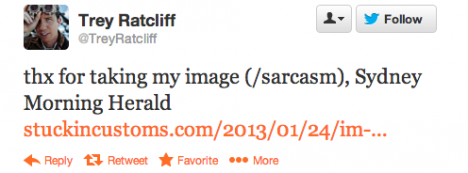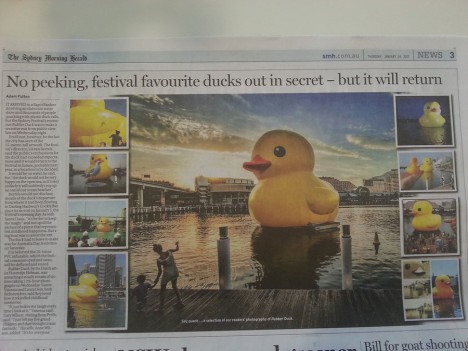SMH in copyright blunder over tweeted duck pic
 The Sydney Morning Herald has apologised after being caught out using an image from social media without permission and claiming it was a reader’s photograph.
The Sydney Morning Herald has apologised after being caught out using an image from social media without permission and claiming it was a reader’s photograph.
Trey Ratcliff, who runs the blog Stuckincustoms.com, wrote a blog post accusing the newspaper of breaching the Creative Commons licence on his site by using a photo of Florentijn Hofman’s Sydney Festival installation “Rubber Duck” and presenting the image as having been voluntarily submitted.



Another possible example – see the picture of the “An artist’s impression, From the Deep” from:
http://www.theage.com.au/enter.....2d9sc.html
That’s not artists impression. It’s someone photo from the Brisbane Festival in 2012 of an installation that was called the City Of Lights. For comparison here is my photo from Brisbane of that installation:
http://photos.dawnstar.id.au/O.....1&s=A
Note the exact same bridge and buildings in the background. The image is clearly someones photo from the event that has been published un-credited. It is possible Fairfax is innocent in this one and has simply published an image provided to them by the event creator – either way this is -not- an artists impression.
So SMH says they were under a deadline, so they didn’t bother to check copyright properly? Talk about playing fast and loose.
Yeah… The acclamed pillars of journalism…the publics right to know, honest reporting, etc., etc. have been flushed down the toilet again by another unethical newspaper. Where do these people get the idea they can represent themselves as a bastion of information for the public good when they themselves are nothing more then curb sucking low life thieves?
The only thing to do to get their attention is to go after their wallets.
I sincerely hope that the photographer takes them to court for the maximum amount of settlement he can get. If it forces the newspaper out of business…that would be a public service in getting another criminal off the streets.
http://www.webpronews.com/you-.....ia_sidebar
If they were under deadline and couldn’t establish who owned the copyright of the image, they should have just pulled the image from the article, simple as that, if in doubt, don’t do it.
What’s the going rate for having one’s freelance photo published in the paper?
I think it is only fair to give Mr. Ratcliff credit. He give people a much freedom in using his photos for their own personal reasons.
Shame on you Sydney Morning Herald. I think a a front page full color apology should be put out for the theft.
This isn’t the first time Fairfax has broken CC rules as I reported at
http://www.technologyspectator.....oto-finish
Trey Ratcliff should send them a big invoice.
it’s a beautiful photo
Some interesting points here
1. The SMH (and other publications) should never use the work of any artist (writers, photographers, cartoonists, etc) without their permission and a by-line.
2. The SMH state they found the image on thedailyblender – this is a blog that steals the work of others and posts it without attribution and then invites viewers to share them. Not exactly an ethical source.
3. I’ve been following Trey Ratcliff for some time – his blog and his tutorials, I admire his work and his generosity – he does not deserve to be ripped off like this.
4. Photographers can embed copyright and contact information in the IPTC fields of the image metadata. This at least alerts honest users of the images to the provenance of the image. Trey for some reason does not include the IPTC info in his files.
If in doubt, leave it out.
The real question is: what constitutes “commercial use”? In the age of the internet and ad networks, what makes a website a “commercial” site? If I publish the photo on my personal blog, but I have Google Ads on my blog, am I using it for commercial purposes?
I would have thought “commercial use” means in advertising/marketing materials, ie not editorial usage. Eg, a footballer can’t stop his image being published in the sports pages, but he can stop it from being used in advertisments without his consent.
Suggest put a watermark on your images so ownership is never in doubt
I think peps are being a bit tough on the Sydney Morning Herald,.
The picture editor tried to contact me last year to ask permission to use a pic from my blog for the Sun Herald but I was unavailable.
They took a chance and used the photo but I was more than happy with the fee I negotiated and let’s face it, many bloggers live in a twilight world of unusual hours that don’t often co-incide with the pressures of a deadline.
Presumably most snappers who publish their work via the internet are happy for a photo to be re-used for a fee and Fairfax are diligent when it comes to paying.
A hiccup yes but in this case, it wasn’t a hangable offense and the upside is we all now know about Trey Ratcliff’s great travel blog !
Under section 42 of the copyright act. This could be given an exemption under the Fair Dealings for the purposes of reporting news.
Creative commons be damned as its overruled.
Although didn’t provide significant acknowledgement of the work. i.e attribution so could be liable as a breach under our laws.
Also interesting to note how different our fair dealings is to US fair use. We have a much clearer provision for reporting news.
I am genuinely amazed at how few people in media organisations have read the copyright act, its fairly important y’all.
OMG bloggers would never do anything as unethical as this.
The big thing here is if it was the other way around, that a new media site or blogger accidently posted a pic or 2 from Fairfax or News Ltd they’d go straight to lawyers, as I discovered some years ago when a contract writer posted some News Ltd shots on a site I then owned.
You’ve got to love how they call mum when they’re never quite as understanding when the situation is in reverse.
This will happen from time to time – just send them a bill.
Anyone with good photos can use TinEye for free to check where else they’re being shown on the web: http://www.tineye.com/
or use Google image search.
TinEye has a great Chrome extension to check photos as you go.
And think about how much to charge – anyone who has used a Getty Image by mistake will know that you’ll get a bill and legal letter in the post for about $1,200 per image. Sounds like a good starting point.
@ Oscar. Understand your views but your comment about thus giving publicity to Trey’s work is a but much. Clearly the SMH should establish ownership a.crefit the artist on the photo, hence giving Trey more publicity than this does.
Gees, Steve Martin and Brett Y – seems a rather fierce overreaction. As long as there are Obeids roaming around, I want the Herald’s journalism to keep them accountable as possible. Long live it. This, on the other hand, is a picture of a duck – a lovely one indeed, and I’m sure the photographer’ll get paid.
In response to @Trevor Connell above: “Trey for some reason does not include the IPTC info in his files.”
I guess you’re unaware that Twitter, for some reason, deletes all metadata as part of the upload process. As does Facebook.
This sort of thing seems to happen constantly at agencies too. Photos stolen and used, illustrations stolen and used, commercial fonts taken and (very) slightly modified before being sold to the client as a “corporate” font.
Jimbo, I think you’re getting a bit confused.
You can’t take a photo of a known celebrity and use it to promote a product because there is an implied endorsement.
This is a separate issue of using someone else’s photo.
And no, newsworthiness under fair use would not apply for a number of reasons that I’m too lazy to write up…
Facebook doesn’t delete metadata – it even shows the copyright status in the caption of the photo.
SMH – you guys are unbelievable… don’t you research the images you print ??!!
Watermarking your photos provides no guarantee of protecting them from copyright infringement. My Blog site features watermarked photos and I ended up discovering more than 10 of my photos and many other peoples were ripped off by a for profit magazine who used them for print magazine, website and Facebook. They dismantled the photos and added their own watermarks. They claimed it was an innocent error – umm yea OK.
Story here
http://bit.ly/LgODz7
I’m not sure why they think their internal deadlines are relevant. That’s a bit like saying “You see officer, I was running really, really late, so I HAD to speed”.
any chance of a “wayback” link to that SMH article – they have pulled it! (LOL).